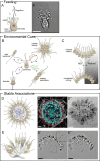What choanoflagellates can teach us about symbiosis
- PMID: 38568895
- PMCID: PMC10990195
- DOI: 10.1371/journal.pbio.3002561
What choanoflagellates can teach us about symbiosis
Abstract
Environmental bacteria influence many facets of choanoflagellate biology, yet surprisingly few examples of symbioses exist. We need to find out why, as choanoflagellates can help us to understand how symbiosis may have shaped the early evolution of animals.
Copyright: © 2024 Arielle Woznica. This is an open access article distributed under the terms of the Creative Commons Attribution License, which permits unrestricted use, distribution, and reproduction in any medium, provided the original author and source are credited.
Conflict of interest statement
The authors have declared that no competing interests exist.
Figures

Comment in
-
Symbiosis: In search of a deeper understanding.PLoS Biol. 2024 Apr 12;22(4):e3002595. doi: 10.1371/journal.pbio.3002595. eCollection 2024 Apr. PLoS Biol. 2024. PMID: 38635919 Free PMC article.
References
-
- Leadbeater BSC. The Choanoflagellates: Evolution, Biology and Ecology. Cambridge University Press; 2015. p. 18–43. doi: 10.1017/cbo9781139051125.003 - DOI
MeSH terms
LinkOut - more resources
Full Text Sources

